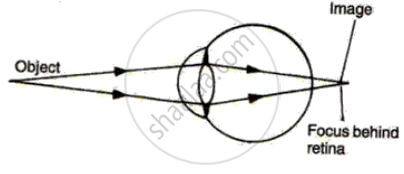Advertisements
Advertisements
प्रश्न
Ciliary muscles of human eye can contract or relax. How does it help in the normal functioning of the eye?
उत्तर
The ciliary muscles of the human eye can contract or relax the eye lens and help in changing the focal length of the eye lens. Because of this, the eyes can focus the images of nearby as well as distant objects on the retina.
We can understand this by following examples:
(a) When the eye is focussing on a distant object. In this case, the ciliary muscles are completely relaxed. The relaxed muscles tightly pull the suspensory ligaments, which in turn pull the eye lens, because of which the eye lens becomes thin. The thin eye lens has a small converging power, which is sufficient to converge the parallel light rays from the distant object to form an image on the retina.
(b) When the eye is focussing on a nearby object. In this case, the ciliary muscles contract, because of which they cannot pull the suspensory ligaments tightly. As the suspensory ligaments are loose, they stop pulling the eye lens, and therefore the eye lens bulges and becomes thick. The thick eye lens has greater converging power, which helps in converging the diverging light rays from the nearby object to form an image on the retina.
APPEARS IN
संबंधित प्रश्न
What job does the pupil of the eye do?
Draw a simple diagram of the human eye and label clearly the cornea, iris, pupil, ciliary muscles, eye-lens, retina, optic nerve and blind spot.
How does the eye change in order to focus on near or distant objects?
(a) The lens moves in or out
(b) The retina moves in or out
(c) The lens becomes thicker or thinner
(d) The pupil gets larger or smaller
Note the relationship between the first two words and suggest the suitable word/words for the fourth place.
Cones : Iodopsim :: Rods : ______.
Give the main function of the following:
Fovea centralis
The diagram alongside represents a certain defect of vision of the human eye.
(i) Name the defect.
(ii) Describe briefly the condition in the eye responsible for the defect.
(iii) Redraw the figure by adding a suitable lens correcting the defect. Label the parts through which light-rays pass.
(iv) What special advantage do human beings derive in having both eyes facing forward?

Choose the correct answer.
In the chemistry of vision, the photosensitive substance is _________________
Write the name.
The part of human eye that transmits electrical signals to the brain.
Match the following:
| Column - I | Column - II | ||
| 1 | Retina | a | Path way of light |
| 2 | Pupil | b | Far point comes closer |
| 3 | Ciliary muscles | c | near point moves away |
| 4 | Myopia | d | Screen of the eye |
| 5 | Hypermetropoia | e | Power of accomodation |
With reference to human eye answer the question that follow:
Name the part of the eye associated with keeping the lens moist and protecting it from physical shock.
